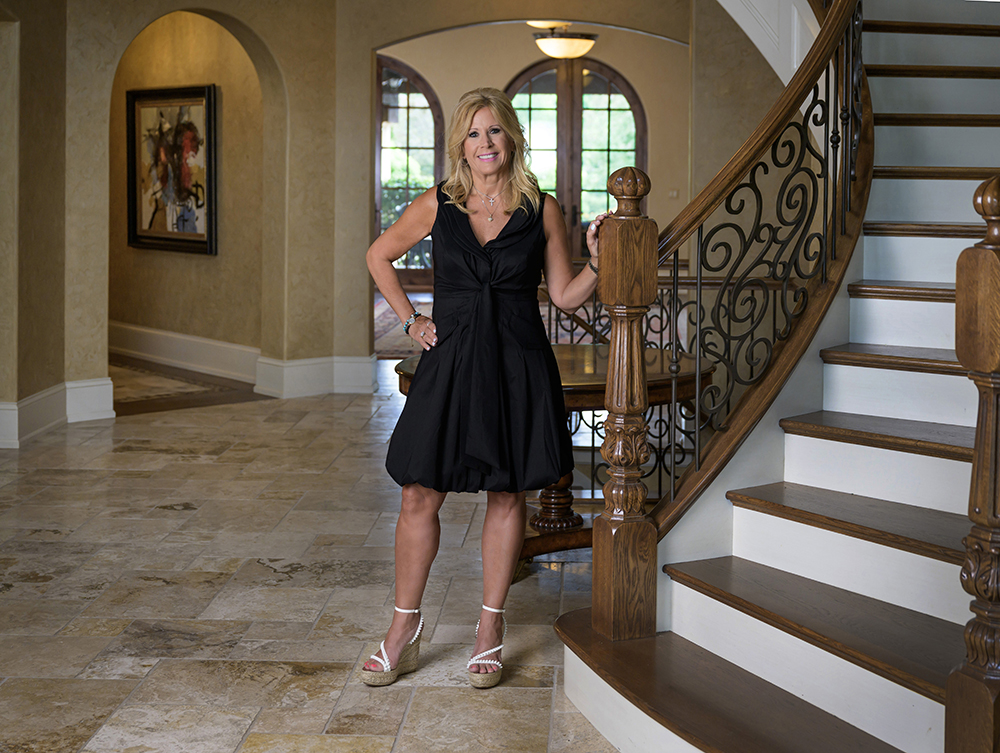Fullersburg
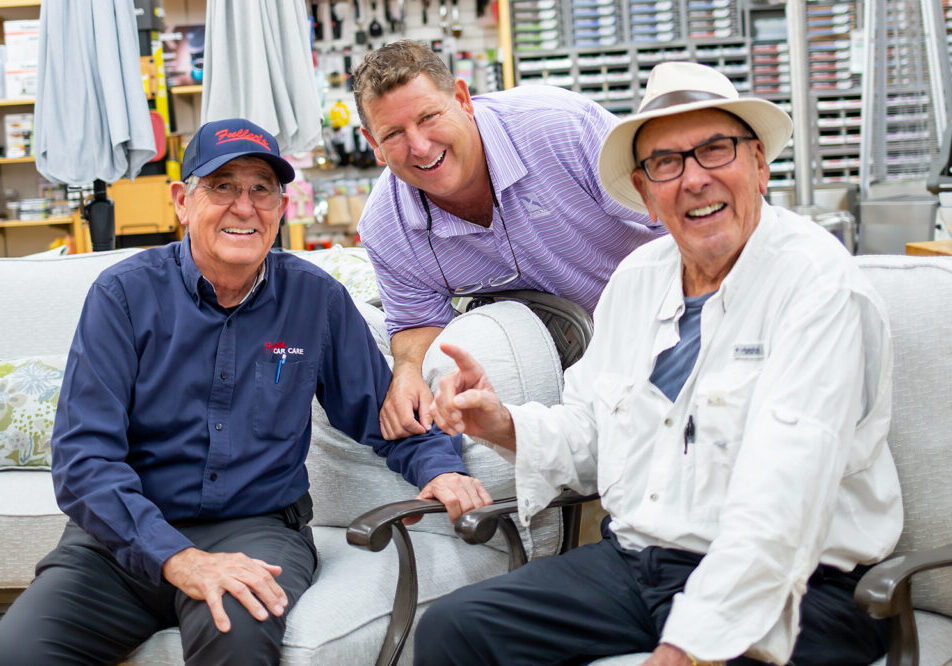
The History of Hinsdale and the Fuller Family Legacy
By Larry Atseff
This is the story of the settlement of land about 17 miles southwest of Chicago in the early 1830’s by Ben Fuller, among others, and the` involvement of the Fuller family from those days, into what is Hinsdale today. We gratefully acknowledge the help of Don Fuller, patriarch of the Fuller family, his website: fullersburg.org, publications on that website, plus “Hinsdale & the World”, by Tom & Mary Sterling, “Hinsdale”, by Sandra Bennett Williams, and the Historical Society of Hinsdale. (Go see the artifacts from this entire era at the Oak Brook Historical Society on Spring Road and 31st Street. Artifacts include “projectile points” aka as arrowheads.)
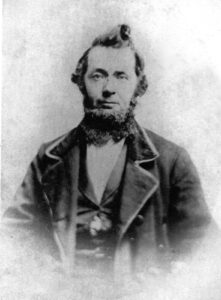
Ben Fuller
How Land, Water, And Key Visionaries, Led To Fullersburg, … and, Eventually To Hinsdale.
Fullersburg, Hinsdale and even Oak Brook have been significantly influenced by the land, and the water upon which they were eventually built. As you will read, in turn, the topography influenced visionaries like Ben Fuller, Fred Graue, William Robbins and Paul Butler, and many others, in their decision making in helping to establish these communities. Even today, the land and water affect us. According to the “Fullersburg Chronicles” (available online at www.fullersburg.org), the influence of the local topography started when the last Ice Age formed a mile high glacier 12,000 years ago. Then, significant climate warming led to “ice and snow melting (until) the land was scoured flat. Landscape features… such as the Salt Creek valley emerged and pine forests grew in to replace the tundra. As warming continued, forests, prairies and wetlands of today replaced the pine forests.” Obviously, all of this took place over thousands of years. The first people to inhabit the land were tribes of Native American hunters, including the Potawatomi, who immigrated to the area hunting for food by following herds of deer, elk and buffalo. In turn, the herds used prairies, forests and wetlands for their sustenance. What became known as Salt Creek became a transportation route for tribes as well as fur traders and explorers, who also were attracted to the area. In 1833, the entire northeastern area of Illinois was deeded by Native Americans to the US Government. It was called the Treaty of Chicago, and it was this step that encouraged families in the eastern US to start coming out west. One of those families were the Fullers.
The Fullers Of Fullersburg
Imagine yourself as Benjamin Fuller, one of 12 children, in Broome County, New York, at the age of 24. According to the “Fullers of Fullersburg”, by George Ruchty, Jr. (also online at www.fullersburg.org): “he left his home and family and headed west in search of the land of his dreams. What he sought was a large tract of fertile soil with fresh, clear streams of water nearby, and open land for farming and forest areas which would provide for lumber for building cabins for shelter.” “Young Ben’s journey was not easy. It led him over Indian trails and around swampy areas until, (after nearly 700 miles) in the spring of 1834 he finally reached Chicago, then a thriving settlement on the western shore of Lake Michigan. What he found was not to his liking. The entire area appeared to him to be a veritable sea of mud. Sidewalks, sometimes three or four feet high, had been built by driving posts into the ground to hold planks of rough lumber, making it possible to get from building to building. On warm nights the mosquitoes were unbearable.” “Ben was just about ready to give up and return home, when by chance, he met a traveler from the west who told him about the beautiful rolling country some 17 miles southwest of Chicago. There, the traveler said, Ben would see those open fields, wooded areas, and streams of clean water the young man had come so far to find.” He took the stranger’s advice and then returned home to New York where he “succeeded in influencing his family to sell the farm and move west’” In the spring of 1835, all 12 children, his Father Jacob and Mother Candace and Ben’s wife Olive got into covered wagons and rode horseback to Illinois.
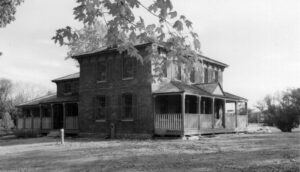
The Fred Graue House
Due to crowding, the two eldest girls went by boat to Chicago. According to Ruchty, they then trekked west to an area where Mays Lake is located (near today’s Route 83 and between 31st Street and 35th Street.) They purchased approximately 160 acres from the government at a cost of $1.25 an acre, cleared land for planting next spring, and for lumber to build a cabin. The cabin was 25 feet long and 15 feet wide…for 13 people (The Fuller family of 12 and Olive, Ben’s wife) As it turned out, the cabin was next to a village of friendly Pottawatamie, who didn’t want to move out of the area right away. In an interesting twist, “Ben taught them how to shoe their ponies, and in appreciation, the Indians gave his young son John a pony named Ninoldi.” As Ruchty also relates: “About this same time, other settlers were going west of Chicago to start Downers Grove and Naper Settlement (Naperville)”… “The old Indian trail west from Chicago was open and improved with each wagon’s passing.” “…low spots were filled in with stone and logs placed across them so wagons could pass during the rainy season.” (Editor’s note: the method of using logs eventually led to the trail being named the Old Plank Trail, complete with collection of tolls. Today, you know it as Ogden Avenue) All during this time, Ben Fuller noticed all the activity and had the foresight to see the potential that was developing before his very eyes. He himself built a frame house to replace the cabin the family lived in earlier. It is now on display on the Graue Mill grounds. From 1835 to 1855, according to Ruchty, Ben Fuller “purchased some 800 acres from the government for what was to become Fullersburg. In the year 1851, Ben Fuller platted the town of Fullersburg to include not only the first hotel which he built, but also what is now the York Tavern. He even made provisions for a school and cemetery.
“The mission of the foundation, working in partnership with the Forest Preserve District of DuPage County, is to raise funds to restore the Ben Fuller Farmhouse and develop educational programs and exhibits. We continue to promote and support and officially declare a Fullersburg Historic District and its heritage sites, complete with signage and maps showing the boundaries of the district and the buildings, the dam and the land that is included.”
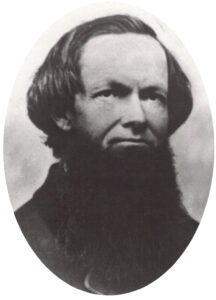
William Robbins, founder of Hinsdale
And, he renamed Brush Hill as Fullersburg.” At approximately the same time, others like the Torode family from France moved into the area. They bought land southeast of Mays Lake, on Salt Creek. They saw more families moving in and built a sawmill and a dam on the creek around 1837 to provide lumber for more and more building. They ran the mill until 1849, when it burned down, and then moved north on York Road to start a stone quarry where Roosevelt Road intersects York Road. Nearby the creek where the Torodes located, was York Road, becoming established as a north and south route, intersecting Old Plank Trail. About the same time, a stagecoach line made the intersection the only stop between Chicago and Naperville. In turn, that led to hotels where people could stay. One of those hotels was built by the Fuller family. Eventually, three taverns opened and another hotel opened, and a wagon maker opened for business, as did a blacksmith. Families moving in were locating in the area that was now called Brush Hill, so called because, according to Ruchty, the area was covered with “dense hazelnut brush which offered food and cover for deer and small game.” (Editor’s note: Brush Hill was the section of land in Hinsdale south of Old Plank Trail, and between what is now Lincoln and Garfield and south to Ayres Avenue.
One of the families moving into the area in 1842 was the Fred Graue family, from Germany. He brought with him expertise in mill construction and operation. In 1850, with the help of people like Sherman King, Graue began construction of a grist mill on the site of the sawmill. The mill was completed and opened in 1852 with internal wooden gear works that were well ahead of their time and are still in place. In fact, the mill is recognized as an Illinois Historic Landmark, for its advanced technology. Graue also rebuilt the dam, “with stones and logs piled on top of the original dam, thus raising the water level in the creek and affording more power to be used grinding the grain.” The mill was not only a place to take corn, wheat, oats and buckwheat to be ground into flour, it also became a gathering place, as farmers waited for their flour. The crossroads of Old Plank Road and York kept growing as a convenient stop between Chicago and beyond Fullersburg to the west out to Naperville. Not only did it accommodate people in the area, it also attracted farmers and their livestock of cattle and hogs on their way to slaughterhouses in Chicago. Again, Fuller saw an opportunity and constructed pens to hold the livestock overnight before they were herded east on Old Plank Road to Chicago.

Loie Fuller danced for the Follies Bergere
All during this time, the Fuller family continued to grow as they married into families in the area. It was duly noted that “Inhabitants were either Fullers, or married to the Fullers”, according to Ruchty. And, so, Fullersburg continued to grow and the area around Old Plank Road, York Road, and Graue Mill, continued to grow. Incidentally, Mary Fuller, a sister of Ben Fuller, taught young children reading, writing and arithmetic. She literally would go from home to home, accompanied by two large dogs, to keep her safe from the wolves. How Topography And Another Visionary Led to The Rise of Hinsdale, and The decline of Fullersburg. According to both Ruchty and fellow historian Sandra Bennett Williams, in her accounting of “Images of America Hinsdale”, the next chapter in the history of Fullersburg occurred “when the Chicago, Burlington & Quincy railroad showed interest in a rail line from Chicago to Aurora, passing through Lyons, Brush Hill (Fullersburg) Downers Grove, and Naperville. As Williams wrote, “In 1858, an enthusiastic petition was presented…by Ben Fuller and Fred Graue, citing the productivity of the town’s mill and the business it could offer the new route. Eventually, the CB&Q railroad agreed to the new track and began studying topography to determine the exact route. What the land survey revealed was devastating to Fullersburg. ‘The joy with which the citizens along the proposed route had greeted the arrival of surveyors was short-lived for the inhabitants of Brush Hill’ wrote Marion Knoblauch in Progress on the Prairie. The cause of this unexpected turn of events lay in the contours of the land and recommendation that the roadbed be built, not through Fullersburg, but a mile to the south, cutting diagonally across the open prairie.” According to Don Fuller, patriarch of the Fuller family these days, the contour referred to was the steep hill at what is now Washington to Lincoln Street that had to be cut through for trains to run.
“I’m proud of the way my family serves the people and how they take care of customers.”
It was determined that making the cut was going to be too expensive compared to the route that would run through Hinsdale. Enter Hinsdale visionary William Robbins in the late 1800s (Editor’s note: Please note how the various accountings of history in this article dovetail so nicely, especially with what follows.) In their extensive accounting of the history of Hinsdale, “Hinsdale & the World”, Tom and Mary Sterling described Hinsdale’s early beginnings as follows: “Hinsdale has always been a commuter village, set up in response to the Chicago, Burlington & Quincy Railroad’s plans to put a spur through this part of the country. It all began with a man named William Robbins, commonly known today as ‘The Father of Hinsdale’. Originally from New York State, by the mid-1800s, Robbins was farming and teaching in McHenry County, Illinois, when he heard of a way to make a quick fortune. Eager to improve his station in life he set out for the goldfields of California to stake his claim. He didn’t mine for gold, however, but chose the wiser path of selling supplies to wealthy miners. After making his fortune he returned to Chicago where he spoke with officials about the railroad, learned about the new spur, and asked permission to accompany the railroad surveyors as they walked the proposed line. When they reached Hinsdale, Robbins knew he had found what he was looking for.” “The gently rolling landscape had no swamps or other deterrents and was a good place to start a village. The year was 1862 when Robbins bought 640 acres at $14 an acre from Robert Jones.

Don Fuller and his wife Kathy
William Robbins drew up plans for the new village, mapped out streets and lined them with thousands of trees. He planted the trees even before the streets were built, explaining that the streets would be by those areas between the saplings.” “Robbins gave the railroad permission to skirt the north side of his property and Alfred Walker, a progressive farmer in northern Hinsdale, gave the railroad permission to skirt the south side of his land, thus clearing the way for the railroad to come through the middle of presentday Hinsdale. Walker and Anson Ayres soon divided their north-side farms for home sites, and others, including Oliver J Stough, came to the village to build homes for the early residents. “To the far north of Hinsdale near the intersection of York and Ogden stood a much earlier settlement known as Fullersburg. Named for Ben Fuller, this area had managed to survive the 1830s thanks to heavy traffic on the Old Plank Road, a toll road leading from Aurora to Chicago now known as Ogden Avenue. Many famous travelers had used this road on their way to and from Chicago including Abraham Lincoln who was known to have stopped at the Graue Mill. When news of the proposed railroad spur reached the area, Fullersburg merchants encouraged railroad officials to build the line along Ogden Avenue. Such a route wasn’t topographically feasible, however, and the railroad chose the Hinsdale location. With this decision, Fullersburg’s fate was sealed. Hinsdale businesses thrived, supported by the railroad and a growing number of residents. Everyone from barbers to bankers sought out the peaceful streets of Hinsdale as an alternative to the hectic life in the city. By the time of its incorporation in 1873, Hinsdale had grown into a popular, wellrespected commuter village, and in this respect, little has changed.”
IMPORTANT NOTE: IN 1923, FULLERSBURG WAS ANNEXED TO HINSDALE
The Fullers From The Late 1800s To Today.
For this, we turned to Fuller family patriarch Don Fuller, 74 years old, and the great, greatgrandson of Ben Fuller. We asked Don, what have the Fullers been doing from the late 1800s to today? He replied, “The evidence is everywhere, sometimes in surprising ways.” For example, he said, there is Loie Fuller, who became a world-famous dancer. She was born in January 1862 in the Castle Inn. To quote Hinsdale historian Sandra Williams, she “was introduced to the stage as a child reciting poetry and performing became her passion. With only modest success in America, Loie found international fame as a dancer, appearing throughout Europe to rave reviews. Paris, where she was embraced by the artistic elite, became her home. Famed artist Jules Cheret captured movements and innovative use of colored spotlights. Her sensational Follies Bergere engagement brought her tremendous success. Renowned for her spellbinding manipulation of flowing silk costumes, her considerable influence on modern dance is recognized to this day.” From the late 1880s to the Second World War or about 60 years, the Fullers kept busy and productive by quietly focusing on farming. About the only notoriety for the family was that Grandfather Walter became successful and known as the “Sweet Corn King”.
From 1946 on, however, the Fullers again started to become more active in the community.
Bob Fuller (his given name was Lloyd), a grandson of Fullersburg founder Ben Fuller, opened a Shell gas station at York and Ogden after he got out of the Navy in 1946. That was history repeating itself. As noted earlier, Ben Fuller himself was starting to be very active in the exact same area 110 years ago. Bob and his wife Dorothy had four boys, Walter, Douglas, Kenneth, and Don, the youngest. Between them, they had 32 children, and according to Don, well over 150 grandchildren. The four boys lived and grew up at 550 N. Oak St, an address where Don and his wife Kathy live today. In operating the gas station at York and Ogden, Bob introduced the idea of washing cars, by hand, and the boys, as they grew up, would learn the value of hard work by washing cars as well. People would leave their cars, and the four young Fullers would wash their cars for them by hand while they were at work. In 1959, Bob Fuller bought a gas station at 102 Chicago Avenue and started to convert it to an automatic wash, complete with tunnel, brushes, water spray and soap spray cleaning equipment.
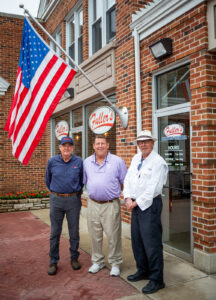
Two generations of Fullers. Don Fuller on the left and Ken Fuller on the right are sons of Bob Fuller. In the middle is their nephew Doug Fuller, son of the late Doug Fuller Sr.
A year later, in 1960, he opened the first Fuller’s Car Wash. He also started selling car wash equipment, a business which is still operating today. They now have 26 Fuller’s Car Washes in the Chicago area. With four boys, Bob also got involved with “Toys for Tots” for the holidays, working with the Marines. And, it was also a time when he got involved with baseball. There were two kinds of youth baseball. There was baseball where everybody got a chance to bat and to play on the field. And then there was Little League baseball, where the best players played and the teams were very competitive. As Don says, “Our Dad taught us how to be competitive as well as hard-working.” Little by little, the Fullers have gotten involved in businesses throughout the community. In 1962, they expanded the car wash services to total car repair services and installation of virtually every tire brand on the market. It is called Fuller’s Service Center and is known for the quality of service. In 2004, Don’s brother, Doug Fuller, and wife Elizabeth took over the Soukup Hardware store and expanded it from a hardware store to add home services with experienced handymen to provide a host of services from Fuller’s Home and Hardware.
Again, no one in town is surprised, given the tradition of high-quality service and family involvement in the business. Today, sisters Paula and Sarah, nieces of Don run the home and hardware store and all the services. They offer Exterior services like gutter cleaning, roof, and siding repair, power washing, fence, and deck repair and installation, window washing, and even window well cleaning. They offer 11 Interior services, everything from light bulb replacement to furniture assembly, interior painting, and eight more services. They offer Electrical services, full Plumbing services, and seasonal services like putting up and taking down decorations, and even snow removal. As they say, Home and Hardware Services, Done Right. For good measure, in 2015, Fullers converted the front of the hardware store into Fuller House, a great place for family dining. And why not? The Fuller House is the Fuller’s way of “paying homage to one of the first settlers of the town. Fuller House is a rustic-chic tavern, located in the heart of downtown Hinsdale.” To conclude this installment, we turn to two sources. One source is a testimonial from a customer about Fuller’s Home & Hardware. The second is how the family takes care of people. Below is a testimonial from a customer of Fuller’s Home & Hardware. It represents the regard the Hinsdale community has for all the Fuller family ventures. “I love Fuller’s Hardware.
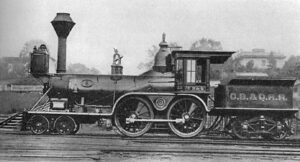
Chicago, Burlington & Quincy Railroad Train
The store itself was recently remodeled and the new interior competes with lots of private homes in Hinsdale. I think it’s a really nice store and the service is GREAT!! You are quite likely to be served by a member of the Fuller family. They are so great and accommodating even if you don’t really know your way around a hardware store (like me). This is an Ace Hardware store that is owned by the Fuller family. The staff is very friendly and attentive. They carry not only supplies but offer services such as moving, repairs, lawn care, decorating/lighting services, and more. I don’t usually come here often because it is a little pricier than when I can just go to Home Depot, but you get the quality service here and it seems to me that anything “Fuller family-owned” gives you that excellent customer service! Great service! We’ve used Fuller’s for installing new light fixtures, installing a dog door, moving some furniture, and a few general handyman things. Always easy to book and they are very pleasant, professional and on time. The quality of the work is great. We had no issues whatsoever. Will definitely call them again.” Back to Don Fuller as the Fuller patriarch.
He is the president of the Fullersburg Historic Foundation and says “The mission of the foundation, working in partnership with the Forest Preserve District of DuPage County, is to raise funds to restore the Ben Fuller Farmhouse and develop educational programs and exhibits. We continue to promote and support and officially declare a Fullersburg Historic District and its heritage sites, complete with signage and maps showing the boundaries of the district and the buildings, the dam and the land that is included.” To sum up, the Fullers of yesterday and today, (and tomorrow) believe, first and foremost, in serving their neighbors. It could be like starting up a community. It could be like washing cars by hand and growing it into an auto repair and tire business, or, it could be expanding beyond a hardware store to providing complete services for inside and outside the home. The family also believes in preserving and honoring history. Overall, it is a good philosophy for running a business, and it sure keeps a growing family involved in the family business.
*Photos provided by the Fuller family












